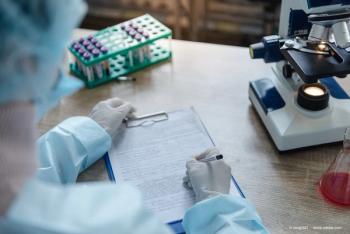
Retina Society 2023: Experimental study of evaporative heavy liquids for retinal tamponade
The investigators performed clinical examinations and obtained fundus photographs and inferior optical coherence tomography (OCT) images for both treatments at baseline and on days 1, 3, 8, 15, and 56 after the injections.
Reviewed by Avnish Deobhakta, MD
A novel heavy liquid that can be used as a retinal tamponade appears to be non-toxic and can evaporate and reabsorb under normal biologic conditions, according to Avnish Deobhakta, MD, assistant professor of ophthalmology, Icahn School of Medicine at Mount Sinai, New York, reported the results at the 56th annual meeting of the Retina Society in New York.
He and his colleagues set out to identify non-toxic canonical heavy liquids for use as retinal tamponades that can evaporate from the vitreous cavity and tested one such liquid, referred to as EOD-1, in 9-week-old Dutch Belted rabbits.
Six eyes of 6 non-vitrectomized rabbits received 8 microliters of EOD-1; the fellow eyes received 8 microliters of balanced salt solution (BSS) and served as controls.
The investigators performed clinical examinations and obtained fundus photographs and inferior optical coherence tomography (OCT) images for both treatments at baseline and on days 1, 3, 8, 15, and 56 after the injections. The intraocular pressures (IOPs) The intraocular pressures (IOPs) were measured at baseline and on days 3, 8, 15, and 56. In addition, electroretinography (ERG) was performed to measure the scotopic a- and b-wave, and photopic b-wave responses in all eyes at baseline and on day 56.
The researchers reported that EOD-1 was seen on the posterior pole on post-injection day 1 in all 6 treated eyes, and by day 8, the liquid had evaporated in all eyes, leaving a relatively large anterior gas bubble near the lens. By day 15, the bubble had decreased in size and by day 56 had greatly decreased in size.
The IOPs and the ERGs did not differ significantly between the treated and untreated eyes throughout the study. The OCT images of the inferior quadrant were normal in all eyes.
Based on the results, the authors concluded that EOD-1 appears to be non-toxic and can evaporate and be reabsorbed under normal biologic conditions. Because of this, EOD-1 has the potential to be used intraoperatively like other heavy liquid tamponades but without being retained in the eye. Conceivably, small amounts of EOD-1 could provide an inferior tamponade in non-vitrectomized eyes at the bedside like an "inverse pneumatic," with subsequent evaporation from the eye.
Avnish Deobhakta, MD
E: adeobhakta@NYEE.EDU
He is an assistant professor of ophthalmology, Icahn School of Medicine at Mount Sinai, New York and has no financial interest in this subject matter.
Newsletter
Keep your retina practice on the forefront—subscribe for expert analysis and emerging trends in retinal disease management.












































